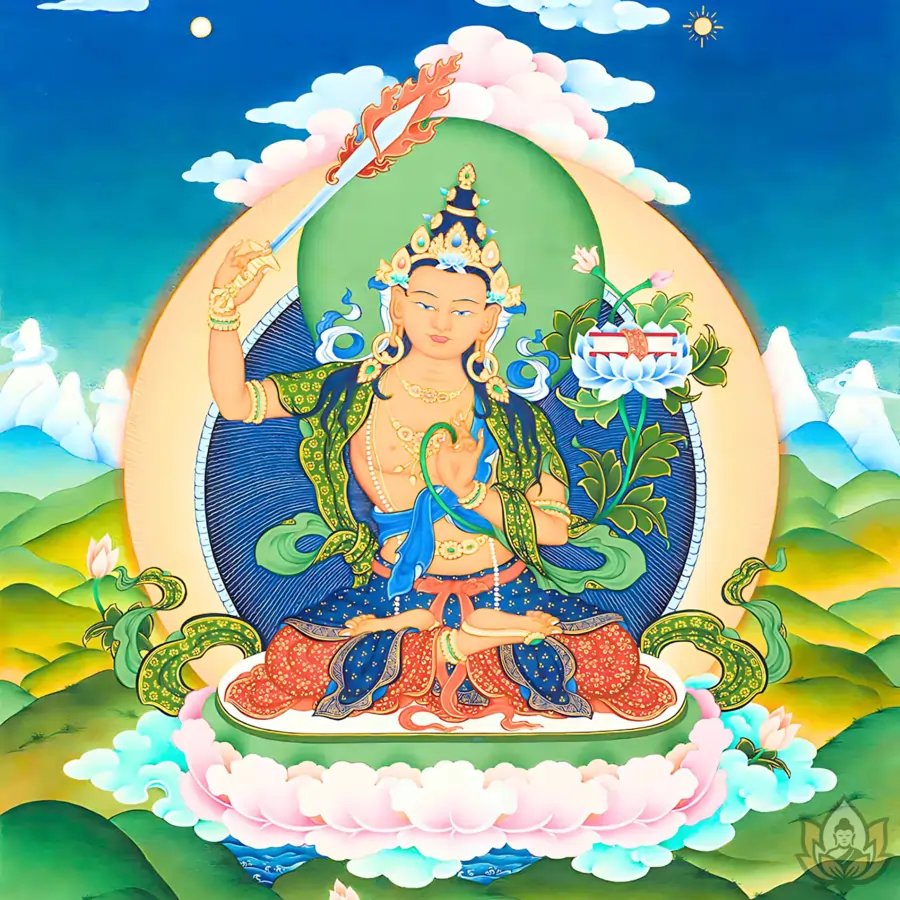The Devotion of Bhikshuni Chuda
One day, Shakyamuni Buddha was narrating to Maitreya about Bhikshuni Chuda (भिक्षुणी चुडा) and how she had dedicated her life to serving the Swayambhu Dharmadhatu. Chuda was renowned for her virtuous conduct and adherence to maidenhood. The shrine of Manjushri had been worshipped by her with unwavering devotion. Daily, she offered pure garlands of lotuses to the Chaitya and expressed her devotion through constant remembrance, meditation, prayer, and worship.
The great Dharani mantra of nine syllables (आद्यां चले चुले वन्दे स्वाहा) had been chanted by her with deep reverence. Through the merit accumulated over twelve years of such practice, she was said to have acquired the five knowledges. Perfected wisdom, plenitude of wealth, prosperity, and manifold virtues had been attained by her. For the benefit of all sentient beings, she upheld the bodhi vows with utmost dedication. She became an arhant, a great scholar, and one pure in mind, speech, and body. Having received the three types of bodhi, it was foretold that she would attain Buddhahood.
Manjushri: The Source of Wisdom and Purity
It was said that those who sought refuge at the shrine of Manjushri (मन्जुश्री) and chanted the Dharani incantations with devotion were freed from their sins. Their minds, speech, and bodies were purified, and they attained prosperity and virtues. Having conquered their bodily desires, they were transformed into bodhisattvas.
They were believed to acquire the five types of knowledge and dwell in the Four Sublime Abodes. By practicing the bodhi vows for the benefit of all sentient beings, they were freed from obstacles and cleansed of impurities. Arhantship was granted to them, along with perfected wisdom. Having achieved the three types of bodhi, they ultimately attained Buddhahood.
It was urged that all must take refuge in Manjushri Chaitya ( See in Map), chanting the Dharaṇī incantations with a bodhi mind. Through the merits gained, their minds, bodies, and speech would be purified, and they would become the children of Buddha. Gentleness, prosperity, virtues, and perfected wisdom were their rewards. They were destined to conquer bodily desires, dwell in the Four Sublime Abodes, and achieve arhantship before finally attaining Buddhahood.


The Sacred Pilgrimage of Swayambhu
The sacred pilgrimage of Swayambhu ( See in Map) is a journey of devotion, worship, and enlightenment. It involves visiting significant holy sites, deities, and divine beings. Pilgrims are guided to follow this path to purify their souls, acquire virtues, and ultimately attain spiritual liberation.
Twelve Holy Tirtha
Pilgrims are encouraged to bathe and donate at each of the twelve sacred tirthas (holy places). Each tirtha holds great spiritual significance, and visiting them with devotion is believed to purify the soul and bring blessings. The twelve tirthas are:
- Sodhani Tirtha – Located in Gokarna, Kathmandu.
- Santa Tirtha – Situated in Guheswari, Kathmandu.
- Sankha Tirtha – Found in Sankhamul, Kathmandu.
- Raja Tirtha – Located in Teku, Kathmandu.
- Manorath Tirtha – Found in Tokha, Kathmandu.
- Nirmala Tirtha – Situated in Shova Bhagawati, Nepal.
- Nidhana Tirtha – Located in Kanga, Kirtipur.
- Jnana Tirtha – Found in Kalimati, Kathmandu.
- Chintamani Tirtha – Situated in Teku Dobhan, Kathmandu.
- Pramoda Tirtha – Located in Kuleshwor, Kathmandu.
- Sulaksana Tirtha – Found in Bhajangal, Kirtipur.
- Jaya Tirtha – Situated in Nakkhu, Kirtipur.
Visiting these sites with a pure heart and offering prayers and donations is believed to grant immense spiritual merit.
Note: Some of these Tirthas no longer exist today due to urbanization, housing developments, and lack of attention from the government.

Five Elemental Deities
The pilgrimage continues with visits to the abodes of the five elemental deities (5 elements – fire, air, earth, water and sky), who represent the fundamental elements of the universe:
- Agnidev – अग्निदेव – The deity of fire, worshipped in Agnipur – अग्निपुर.
- Vayudev – वायुदेव – The deity of air, venerated in Vayupur – वायुपुर.
- Vasundhara Devi – वसुन्धरा देवी – The goddess of earth, honored in Vasupur – वासुपुर.
- Nagadev – नागदेव – The deity of water, revered in Nagapur – नागपुर.
- ShrimatSambara – श्रीमत्सम्बर – The deity of sky (space), worshipped in Shantipur – शान्तिपुर.

Prayers and offerings to these deities are believed to harmonize the elements within oneself and bring balance and peace.
Eight Vitaragas
Pilgrims are urged to pay homage to the eight vitaragas (वीतराग) which symbolize liberation and detachment from worldly desires:
- Manichuda Vitaraga – मणिचूड वीतराग – Worshipped in Sankhu ( See in Map).
- Gokarna Vitaraga – गोकर्ण वीतराग – Revered in Gokarna ( See in Map).
- Kileshvara Vitaraga – कीलेश्वर वीतराग – Honored in Changu ( See in Map).
- Kumbheshvara Vitaraga – कुम्भेश्वर वीतराग – Worshipped in Patan ( See in Map).
- Garteshvara Vitaraga – गर्तेश्वर वीतराग – Venerated in Pharping (now known as Gopaleshor temple) ( See in Map).
- Phanikeshvara Vitaraga – फणिकेश्वर वीतराग – Also revered in Pharping (now known as Shesh Narayan temple) ( See in Map).
- Gandhesvara Vitaraga – गन्धेश्वर वीतराग – Honored in Chobhar (now known as Jal Vinayak temple) ( See in Map).
- Vikrameshvara Vitaraga – विक्रमेश्वर वीतराग – Worshipped in Sitapaila (now known as Aadeshwar temple) ( See in Map).
Praising and serving these vitaragas is said to help pilgrims progress on the path of enlightenment.
Worship of the Great Goddess Khaganana Guheswari
Pilgrims are guided to seek refuge in the Great Goddess Khaganana Nairatyma Guheswari ( See in Map), who embodies divine power and grace. She is to be worshipped with prayers, praises, and homage. Her blessings are believed to purify the soul and grant protection and guidance on the spiritual path.
Shrine of Manjushri and Shantikar Vajracharya
The shrine of Manjushri in Manjushri Hill ( See in Map), the embodiment of wisdom, is a significant stop in the pilgrimage. Devotees are to offer worship, serve the shrine, and chant the sacred Dharani mantras with devotion.

Inside the Shantipur Temple ( See in Map), a Shantikar Vajracharya can be found in a state of deep trance. Pilgrims are instructed to worship, serve, and praise him with respect and devotion. Similarly, other great beings serving the Dharmadhatu are to be venerated and honored.

Rewards of the Pilgrimage
Through this sacred journey, the soul is believed to be purified. Pilgrims become sources of virtue, glory, and auspiciousness. By crossing the steps of bodhi, they are transformed into bodhisattvas, mahasattvas, and protectors of the world.
With dedication and faith, pilgrims can attain arhantship, acquire bodhi knowledge, and ultimately achieve Buddhahood. The blessings of the Dharmadhatu grant happiness, contentment, and spiritual fulfillment. Pilgrims are urged to embark on this sacred journey joyously, worshipping and paying homage at each holy site to realize the ultimate truth.
This sacred pilgrimage serves as a path to enlightenment, teaching devotion, selflessness, and the pursuit of wisdom.
The Merit of Swayambhu’s Origin Story
Listening to or reading the origin story of Swayambhu Dharmadhatu, as described in the Swayambhu Purana, brings immense spiritual merit and acts as a key to attaining sambodhi (enlightenment). This story is considered sacred, and its significance lies in its ability to inspire devotion, purify the soul, and guide listeners toward the path of ultimate enlightenment.
Blessings from Reverent Listening
Those who listen to the origin story of Swayambhu with respect and devotion will gain tremendous merit. The Buddhist text on Swayambhu’s origin is the Swayambhu Purana (स्वयम्भू पुराण). By understanding its sacred teachings, individuals are guided to lead a virtuous and fulfilling life. Reverently engaging with the story ensures that listeners will never face misery or disgrace. They will always remain in a good state of being, adorned with virtue, glory, and prosperity.
The Path to Enlightenment
Listening to this story encourages individuals to practice the bodhi vow, which is a commitment to benefit all sentient beings. Through this vow, listeners become spiritually enlightened and are destined to become lords of the world and children of Buddha.
As they progress on the steps of bodhi (enlightenment), they purify their minds, speech, and actions. Eventually, they become Arhants, achieving liberation from worldly desires. After attaining the three types of bodhi, they are destined to become Buddhas, fully enlightened beings who bring light and wisdom to the world.
The Rarity and Greatness of Swayambhu’s Story
The story of Swayambhu is rare and precious, as it carries the power to grant bodhi knowledge. Those who listen to or tell this sacred tale regularly are blessed with the virtues of the dharma (teachings of Buddha). By doing so, they gain glory, prosperity, and enlightenment.
Devotion to this story ensures that individuals will always remain in a good state, free from misery or wretchedness. They receive the spiritual strength to overcome challenges and are rewarded with wisdom and a deep connection to the truth of existence.
Chanting and Meditating on Swayambhu
To fully embrace the teachings of this sacred text, individuals are encouraged to chant the name of Swayambhu with immense veneration and meditate on its profound meaning. This act of devotion amplifies the blessings received and strengthens the spiritual bond with the Swayambhu Dharmadhatu.
By joyously listening to and reflecting on this story, individuals immerse themselves in its teachings, gaining both spiritual fulfillment and the guidance needed to walk the path of enlightenment.
In conclusion, the origin story of Swayambhu serves as a beacon for those seeking spiritual growth and enlightenment. It offers an unparalleled opportunity to purify one’s soul, embrace virtues, and attain Buddhahood. It is a tale to be cherished, shared, and revered with utmost devotion.
Swayambhu Purana – Table of Contents
« Chapter 10: Shantikar and Good Rainfall

